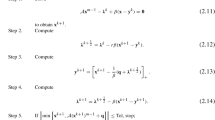Abstract
A tensor given by its canonical decomposition is approximated by another tensor (again, in the canonical decomposition) of fixed lower rank. For this problem, the structure of the Hessian matrix of the objective function is analyzed. It is shown that all the auxiliary matrices needed for constructing the quadratic model can be calculated so that the computational effort is a quadratic function of the tensor dimensionality (rather than a cubic function as in earlier publications). An economical version of the trust region Newton method is proposed in which the structure of the Hessian matrix is efficiently used for multiplying this matrix by vectors and for scaling the trust region. At each step, the subproblem of minimizing the quadratic model in the trust region is solved using the preconditioned conjugate gradient method, which is terminated if a negative curvature direction is detected for the Hessian matrix.
Similar content being viewed by others
References
R. Bellman, Adaptive Control Processes: A Guided Tour (Princeton Univ. Press, Princeton, NJ, 1961).
G. Beylkin and M. J. Mohlenkamp, “Algorithms for Numerical Analysis in High Dimensions,” SIAM J. Sci. Comput. 26, 2133–2159 (2005).
A. Evrim and V. Bülent, “Unsupervised Multiway Data Analysis: A Literature Survey,” IEEE Trans. Knowledge Data Eng. 21 (1), 6–20 (2009).
T. Zhang and G. H. Golub, “Rank-One Approximation to High Order Tensors,” SIAM J. Matrix Anal. Appl. 23, 534–550 (2001).
I. V. Oseledets and D. V. Savost’yanov, “Minimization Methods for Approximating Tensors and Their Comparison,” Zh. Vychisl. Mat. Mat. Fiz. 46, 1725–1734 (2006) [Comput. Math. Math. Phys. 46, 1641-1650 (2006)].
V. A. Kazeev, “On the Problem of Canonical Tensor Decomposition and an Algorithm for Its Solution as Applied to Search for Fast Matrix Algorithms,” Proceedings of the 51st MFTI Scientific Conference on Modern Problems in Fundamental Sciences and Applications, part VIII: Problems im Modern Physics (MFTI, Moscow, 2008), pp. 225-228.
M. Espig, PhD Thesis (Univ. Leipzig, Leipzig, 2008).
J. D. Caroll and J. J. Chang, “Analysis of Individual Differences in Multidimensional Scaling via an N-Way Generalization of Eckart-Young Decomposition,” Psychometrika 35, 283–319 (1970).
R. A. Harshman, “Foundations of the PARAFAC Procedure: Models and Conditions for an Explanatory Multimodal Factor Analysis,” UCLA Working Papers in Phonetics 16, 1–84 (1970).
V. de Silva and L.–H. Lim, “Tensor Rank and the Ill-Posedness of the Best Low-Rank Approximation Problem,” SIAM J. Matrix Anal. Appl. 30, 1084–1127 (2008).
E. E. Tyrtyshnikov, Matrix Analysis and Linear Algebra (Fizmatlit, Moscow, 2007) [in Russian].
M. J. Mohlenkamp and L. Monzon, “Trigonometric Identities and Sums of Separable Functions,” Math. Intelligencer 27 (2), 65–69 (2005).
T. Steihaug, “The Conjugate Gradient Method and Trust Regions in Large Scale Optimization,” SIAM J. Numer. Anal. 20, 626–637 (1983).
J. Nocedal and S. Wright, Numerical Optimization (Springer-Verlag, New York, 1999).
G. A. Shultz, R. B. Schnabel, and R. H. Byrd, “A Family of Trust-Region-Based Algorithms for Unconstrained Minimization with Strong Global Convergence Properties,” SIAM J. Numer. Anal. 22, 47–67 (1985).
R. H. Byrd and G. A. Shultz, “A Trust Region Algorithm for Nonlinearly Constrained Optimization,” SIAM J. Numer. Anal. 24, 1152–1170 (1987).
R. H. Byrd, R. B. Schnabel, and G. A. Shultz, “Approximate Solution of the Trust Regions Problem by Minimization over Two-Dimensional Subspaces,” Math. Program. 40, 247–263 (1988).
D. M. Gay, “Computing Optimal Locally Constrained Steps,” SIAM J. Sci. Stat. Comput. 2 (2), 186–197 (1981).
D. C. Sorensen, “Newton’s Method with a Model Trust Modification,” SIAM J. Numer. Anal. 19, 409–426 (1982).
D. Ž. Djoković, “On the Hadamard Product of Matrices,” Math. Z. 86 (5), 395 (1965).
R. A. Horn and C. R. Johnson, Matrix Analysis (Cambridge Univ. Press, Cambridge, 1985).
V. Strassen, “Gaussian Elimination Is Not Optimal,” Numer. Math. 13, 354–356 (1969).
J._M. Landsberg, “The Border Rank of the Multiplication of 2 × 2 Matrices in Seven,” J. Am. Math. Soc. 19, 447–459 (2005).
H.-J. Flad, B. N. Khoromskij, D. V. Savostyanov, and E. E. Tyrtyshnikov, “Verification of the Cross 3D Algorithm on Quantum Chemistry Data,” Russ. J. Numer. Anal. Math. Model. 23 (4), 210–220 (2008).
Author information
Authors and Affiliations
Corresponding author
Additional information
Original Russian Text © V.A. Kazeev, E.E. Tyrtyshnikov, 2010, published in Zhurnal Vychislitel’noi Matematiki i Matematicheskoi Fiziki, 2010, Vol. 50, No. 6, pp. 979–998.
Rights and permissions
About this article
Cite this article
Kazeev, V.A., Tyrtyshnikov, E.E. Structure of the Hessian matrix and an economical implementation of Newton’s method in the problem of canonical approximation of tensors. Comput. Math. and Math. Phys. 50, 927–945 (2010). https://doi.org/10.1134/S0965542510060011
Received:
Published:
Issue Date:
DOI: https://doi.org/10.1134/S0965542510060011




